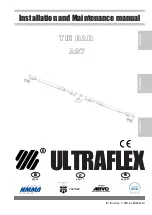
8
I/O Card Positions A, B, C & D
OF FIRE REPLACE ONLY WITH THE
ETHERNET
PRIMARY
SECONDARY
A
1
2
3
4
1
2
3
4
B
C
D
IN
OUT
CAUTION:
TO REDUCE THE RISK
SAME TYPE AND RATING OF FUSE
AVIS:
UTILISER UN FUSIBLE DE
RECHANGE DE MEME TYPE
THIS EQUIPMENT MUST BE EARTHED
MANUFACTURED IN THE USA BY BSS AUDIO
RS232
LOCATE
S
S
S
S
S
S
S
S
S
S
S
S
S
S
S
S
WORD CLOCK
T1.6AH - 250V FUSE
100-240V ~ 50/60Hz, 55W
CobraNet
BLU link
IN
OUT
These connectors provide the balanced connections for the I/O card fitted in the four card slots in a Soundweb
London device. The analogue connections are balanced, on Phoenix/Combicon connectors. A green LED next
to the slot assignment letter A, B, C or D indicates that an Input card is fitted and an amber LED when an output
card is fitted. Digital input cards are indicated with a blue LED and digital outputs cards with a red LED. AEC
input cards are indicated with a white LED. Telephone Hybrid cards are indicated with a yellow LED.
CONTROL INPUTS
There are 12 control inputs, also known as ‘General Purpose Inputs’ or ‘GPI’.
The control inputs are used to connect contact closures (for control of binary
parameters, such as mutes), resistor ladders (for control of multistate parameters,
such as source selectors) or potentiometers (for control of continuous parameters,
such as volume faders). There are two common (ground) connections ‘C’ to the left
of the 12 control inputs, and two software-assignable reference voltage outputs
‘R’ to the right. The control ports have two modes of operation: 2-wire and 3-wire.
2-Wire Mode
In this mode, the 12 control inputs are internally ‘pulled up’ to +5V
DC via a 4.7kOhm resistor. Therefore, no external voltage source
is needed to create contact closure to ground for switches such
as mute buttons or, resistance to ground (for other multi-state or
continuous controls such as Parameter Presets or faders).
See the Soundweb London help for a table of resistor values for use
with Parameter Presets or source selectors.
A 47kOhm-log potentiometer connected between a control input
and common will allow parameters to be controlled linearly.
switch
2-wire mode
3600R
1800R
1200R
unconnected
ladder
47kOhm
log
potentiometer
470R
3-Wire Mode
This mode allows the use of linear pots or faders for continuous
controls. A pot would be wired as a potential divider with the top
of the track connected to the reference output R, the wiper to a
control input and the bottom of the track to a common C. High
performance pots with track resistance between 10kOhms and
100kOhms are recommended.
10K-100kOhm
linear
potentiometer
switch
1k
1k
1k
ladder
1k
4k7
3-wire mode





























